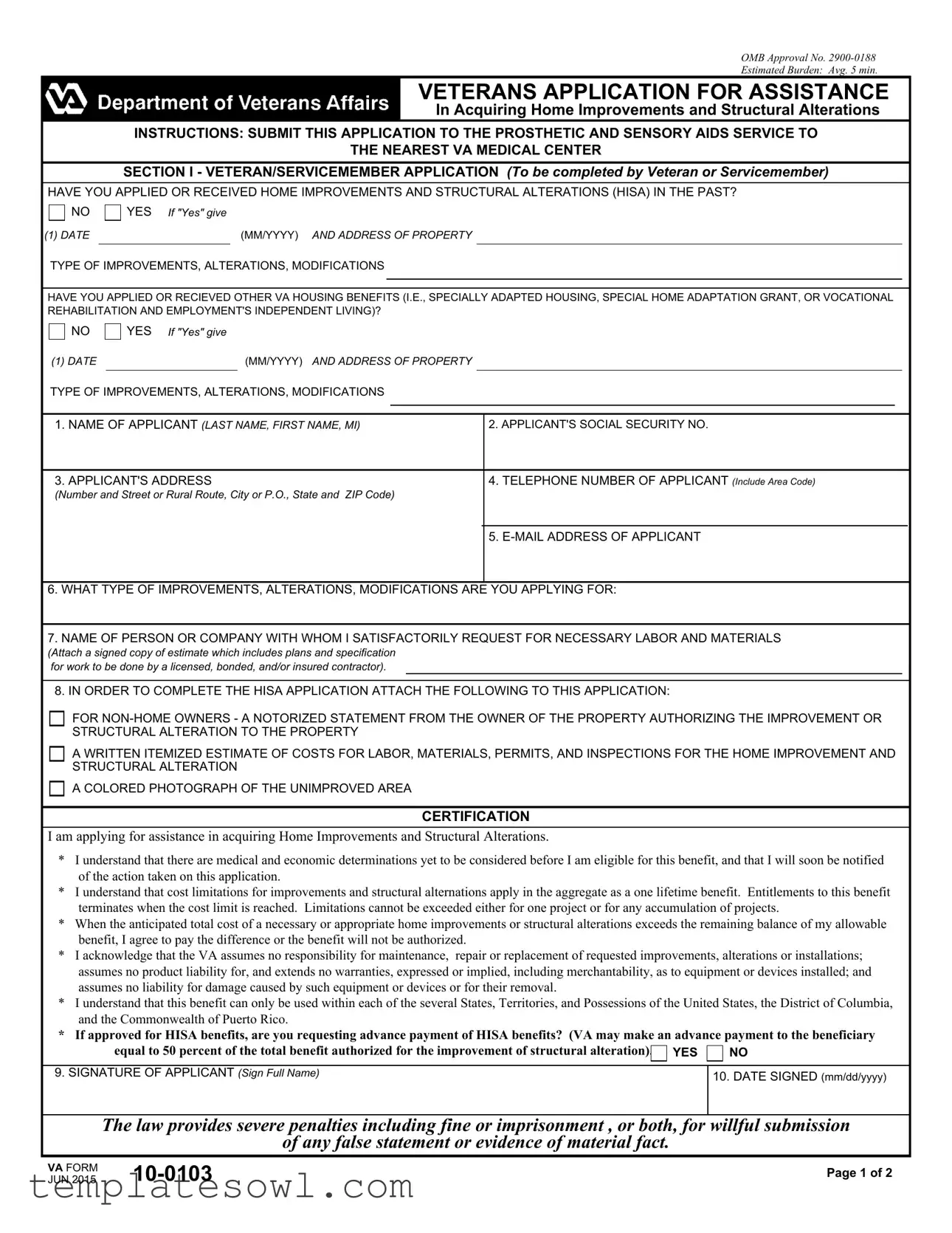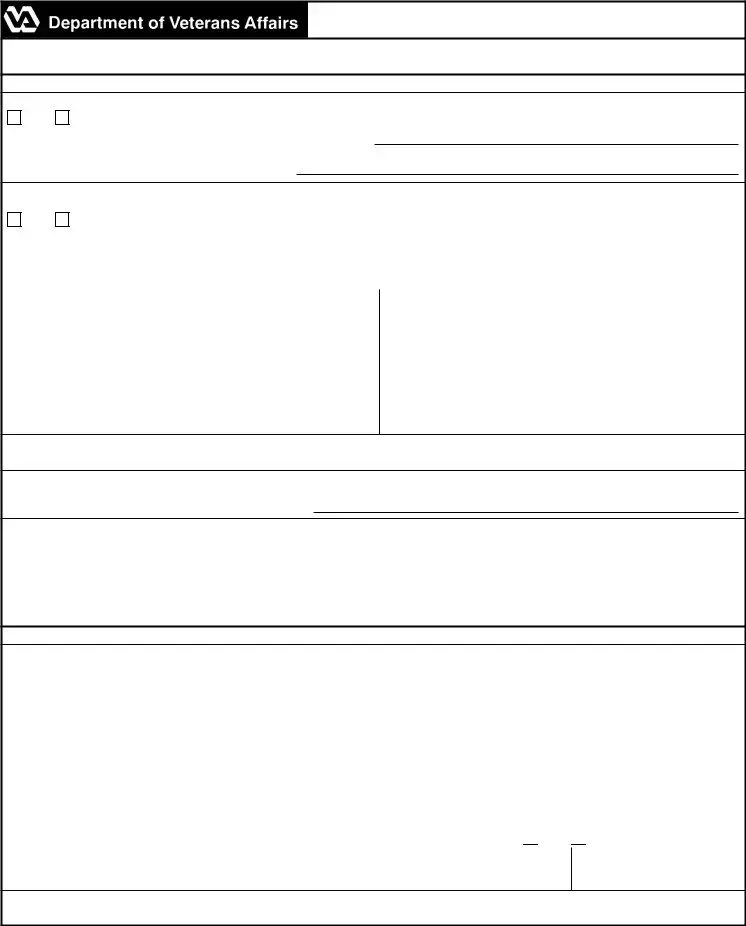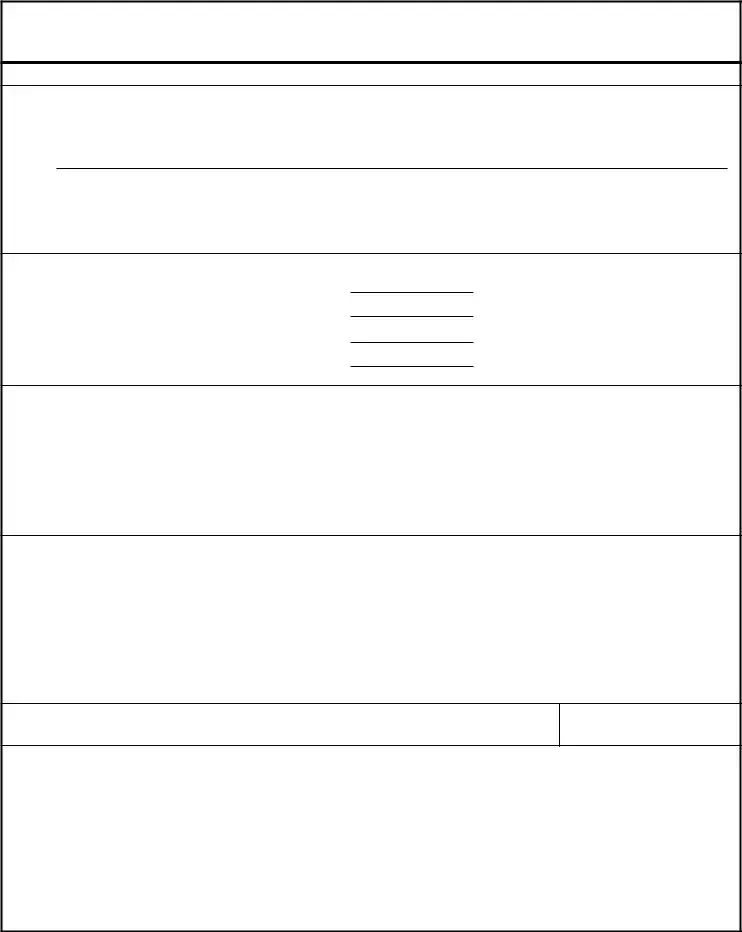OMB Approval No. 2900-0188
Estimated Burden: Avg. 5 min.
VETERANS APPLICATION FOR ASSISTANCE
In Acquiring Home Improvements and Structural Alterations
INSTRUCTIONS: SUBMIT THIS APPLICATION TO THE PROSTHETIC AND SENSORY AIDS SERVICE TO
THE NEAREST VA MEDICAL CENTER
SECTION I - VETERAN/SERVICEMEMBER APPLICATION (To be completed by Veteran or Servicemember)
HAVE YOU APPLIED OR RECEIVED HOME IMPROVEMENTS AND STRUCTURAL ALTERATIONS (HISA) IN THE PAST?
NO |
YES If "Yes" give |
(1) DATE |
|
(MM/YYYY) AND ADDRESS OF PROPERTY |
TYPE OF IMPROVEMENTS, ALTERATIONS, MODIFICATIONS
HAVE YOU APPLIED OR RECIEVED OTHER VA HOUSING BENEFITS (I.E., SPECIALLY ADAPTED HOUSING, SPECIAL HOME ADAPTATION GRANT, OR VOCATIONAL REHABILITATION AND EMPLOYMENT'S INDEPENDENT LIVING)?
NO |
YES If "Yes" give |
|
|
|
|
(1) DATE |
|
(MM/YYYY) AND ADDRESS OF PROPERTY |
|
|
|
|
|
TYPE OF IMPROVEMENTS, ALTERATIONS, MODIFICATIONS |
|
|
|
|
|
|
|
|
|
|
|
|
|
|
|
|
|
|
|
|
|
1. NAME OF APPLICANT (LAST NAME, FIRST NAME, MI) |
2. APPLICANT'S SOCIAL SECURITY NO. |
|
|
|
|
|
|
|
|
|
3. APPLICANT'S ADDRESS |
4. TELEPHONE NUMBER OF APPLICANT (Include Area Code) |
|
(Number and Street or Rural Route, City or P.O., State and ZIP Code) |
|
|
|
|
|
|
|
|
|
|
|
|
|
|
|
|
|
|
5. E-MAIL ADDRESS OF APPLICANT |
|
6.WHAT TYPE OF IMPROVEMENTS, ALTERATIONS, MODIFICATIONS ARE YOU APPLYING FOR:
7.NAME OF PERSON OR COMPANY WITH WHOM I SATISFACTORILY REQUEST FOR NECESSARY LABOR AND MATERIALS
(Attach a signed copy of estimate which includes plans and specification for work to be done by a licensed, bonded, and/or insured contractor).
8.IN ORDER TO COMPLETE THE HISA APPLICATION ATTACH THE FOLLOWING TO THIS APPLICATION:
FOR NON-HOME OWNERS - A NOTORIZED STATEMENT FROM THE OWNER OF THE PROPERTY AUTHORIZING THE IMPROVEMENT OR STRUCTURAL ALTERATION TO THE PROPERTY
A WRITTEN ITEMIZED ESTIMATE OF COSTS FOR LABOR, MATERIALS, PERMITS, AND INSPECTIONS FOR THE HOME IMPROVEMENT AND STRUCTURAL ALTERATION
A COLORED PHOTOGRAPH OF THE UNIMPROVED AREA
CERTIFICATION
I am applying for assistance in acquiring Home Improvements and Structural Alterations.
*I understand that there are medical and economic determinations yet to be considered before I am eligible for this benefit, and that I will soon be notified of the action taken on this application.
*I understand that cost limitations for improvements and structural alternations apply in the aggregate as a one lifetime benefit. Entitlements to this benefit terminates when the cost limit is reached. Limitations cannot be exceeded either for one project or for any accumulation of projects.
*When the anticipated total cost of a necessary or appropriate home improvements or structural alterations exceeds the remaining balance of my allowable benefit, I agree to pay the difference or the benefit will not be authorized.
*I acknowledge that the VA assumes no responsibility for maintenance, repair or replacement of requested improvements, alterations or installations; assumes no product liability for, and extends no warranties, expressed or implied, including merchantability, as to equipment or devices installed; and assumes no liability for damage caused by such equipment or devices or for their removal.
*I understand that this benefit can only be used within each of the several States, Territories, and Possessions of the United States, the District of Columbia, and the Commonwealth of Puerto Rico.
*If approved for HISA benefits, are you requesting advance payment of HISA benefits? (VA may make an advance payment to the beneficiary
equal to 50 percent of the total benefit authorized for the improvement of structural alteration).
 YES
YES 
 NO
NO
9. SIGNATURE OF APPLICANT (Sign Full Name) |
10. DATE SIGNED (mm/dd/yyyy) |
The law provides severe penalties including fine or imprisonment , or both, for willful submission
of any false statement or evidence of material fact.



 YES
YES 
 NO
NO